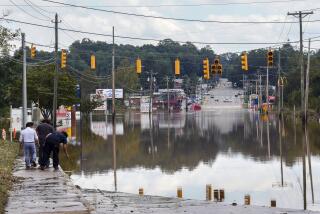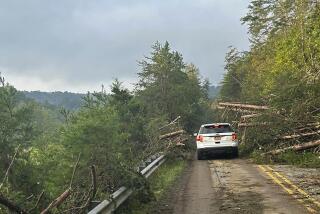Mid-Atlantic States Wilt Amid Prolonged Heat
RALEIGH, N.C. — A week after the federal government declared much of drought-plagued North Carolina a disaster area, much of the mid-Atlantic region coped Tuesday with another day of sizzling heat and dripping humidity, leaving some residents here wondering whether the four-year dry spell would ever end.
Temperatures hovered around 100 degrees and the heat index--a combination of heat and humidity that determines how hot it feels--reached 110. Weather officials offered sweat-drenched residents a piece of advice: “Goodness gracious, stay in the air-conditioning,” meteorologist Mike Moneypenny told the Durham Herald-Sun.
On his tobacco farm in Bailey, 30 minutes east of here, Pender Sharp headed out in the fields in his red pickup truck, carrying a cooler loaded with ice, water and soft drinks. “You’ve got to get the water to the fieldworkers twice a day in weather like this,” he said. “Otherwise, they’d fry.”
In Wilson, down Highway 264, nearly 50 kids showed up for the first day of high school football practice. They spent as much time gulping water as they did doing sprints. “I couldn’t even tell you how many water breaks we took,” coach Randy Raper said.
The heat stretched down the Atlantic seaboard, causing some power outages but few complaints in North Carolina as power plants were overloaded by too many air conditioners turned up full blast. For native Carolinians, breathless heat and dreams of retreating to the cool of the mountains is how summers are lived, day in and day out.
Although what newspapers referred to a “cool spell” was predicted later in the week, with temperatures dropping into the low 90s, the dry, hot weather offered no foreseeable relief from North Carolina’s long drought--reminiscent of other multiyear droughts the state went through in the 1920s, ‘50s and ‘80s.
Last week’s federal disaster declaration allows farmers to seek relief from the drought that has dried up lakes and parched crops.
“We’re headed for a crop disaster this year” because of the drought, said Peter Daniel, assistant to the president of the North Carolina Farm Bureau. The state is agriculturally diverse, with bountiful yields of tobacco, sweet potatoes, melons, cucumbers, cotton and soybeans.
Because of the drought, some farmers have had to import hay for their cows from states as far away as Indiana, doubling their freight costs. Snakes in larger than usual numbers have been seen in the open as they crawl out of woodpiles and other cool shelters in search of food and water. Many communities have imposed water restrictions.
Gov. Mike Easley has asked towns in drought-stricken areas to cut water consumption by 20%, and Charlotte has imposed voluntary restrictions: no filling swimming pools, no watering sidewalks, no washing cars by hand, no glasses of water in restaurants unless customers specifically ask for one.
The town of Statesville last week issued its first-ever citations to water violators, fining three businesses $100 each for ignoring earlier warnings. Officials said the water supplies Statesville gets from the South Yadkin River could dry up by October.
Some areas of North Carolina are 5 feet below normal rainfall since 1988. The Charlotte Observer reported that Charlotte, the state’s largest city, is 6 inches below normal this year and 45 inches below normal since 1988.
More to Read
Sign up for Essential California
The most important California stories and recommendations in your inbox every morning.
You may occasionally receive promotional content from the Los Angeles Times.










